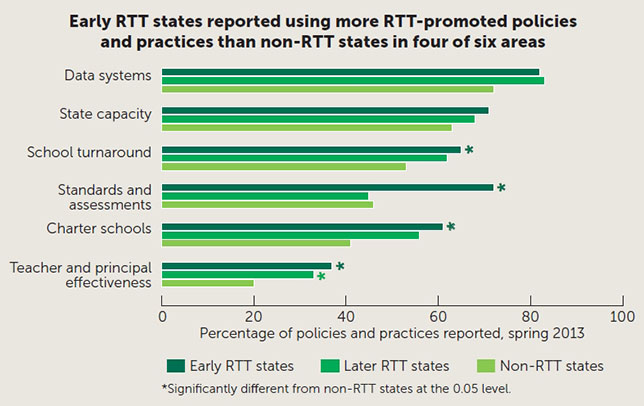Race to the Top Funding Impact on Student Outcomes 'Not Clear'
- By Dian Schaffhauser
- 11/10/16
While Race to the Top (RTT) funding did introduce more use of the policies and best practices promoted by the federal program, the impact of those changes on student achievement is "unclear," according to the latest reporting from an ongoing study undertaken for the United States Department of Education's Institute of Education Sciences.
In 2010, 11 states and the District of Columbia received $4.35 billion in two rounds of RTT grants based both on their education reform plans and their past success in creating conditions for reform. In an evaluation led by Mathematica Policy Research and supported by the American Institutes for Research and Social Policy Research Associates researchers found that these "early" states reported the use of RTT-promoted activities in four of six areas more successfully than states that didn't receive the grants:
- Turning around low-performing schools;
- Adopting standards and assessments that prepare students to succeed in college and the workplace;
- Encouraging conditions in which charter schools can succeed; and
- Improving teacher and principal effectiveness.
However, the researchers emphasized, those differences may not be directly tied to RTT, since states were already using some of those practices when they received the grants.

In two other areas — building state data systems that measure student growth and inform instruction and improving state capacity to support school improvement efforts — there were no differences between states that did or didn't receive the grants.
The seven states that that received their RTT grants in 2011, during a third round of funding, reported using more practices related to teacher and principal certification and evaluation than non-RTT states in spring 2013.
Overall, states' use of practices — whether they were RTT recipients or not — was lowest in the area of teacher and principal certification and evaluation (26 percent). It was highest in the use of data systems (76 percent). The largest difference between states with and without RTT grants showed up in standards and assessments.
Also, early RTT states reported using more English language learner (ELL)-focused policies and practices promoted by RTT than non-RTT states. No differences were found in that area between "later" RTT states and non-RTT states.
Figuring out what impact RTT has had on student progress was difficult, the report noted, because the outcomes could be interpreted in several ways: "as providing evidence of a positive effect of RTT, a negative effect of RTT, or no effect of RTT." The uncertainty was "partly due," the researchers explained, "to the difficulty in separating the effect of RTT from overall trends in student outcomes and partly due to the limited amount of data available for the analysis."
"In sum, it is not clear whether the RTT grants improved student achievement," said, Mathematica Senior Researcher Lisa Dragoset, who led the evaluation, in a statement. "Differences in student achievement between RTT states and other states may be due to other factors and not to the program. For example, RTT states differed from other states before receiving the grants in a number of ways. Other changes that occurred at the same time as RTT reforms may also have affected student achievement."
To develop their findings, the researchers held phone interviews with representatives from state education agencies in all 50 states as well as the District of Columbia, collecting information about educational policies, practices and support related to the six areas that RTT promoted. Analysis of the tie between RTT and student achievement was based on publicly available, state-level test scores from the National Assessment of Educational Progress (NAEP).
The full 267-page report is available on the Mathematic website here. A two-page summary is available here.
About the Author
Dian Schaffhauser is a former senior contributing editor for 1105 Media's education publications THE Journal, Campus Technology and Spaces4Learning.